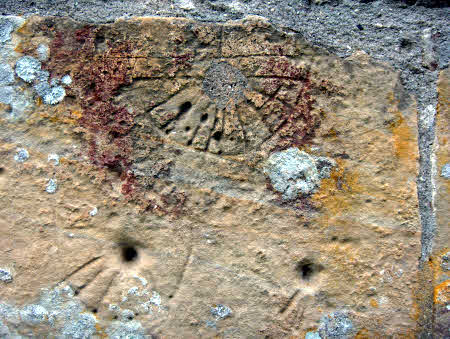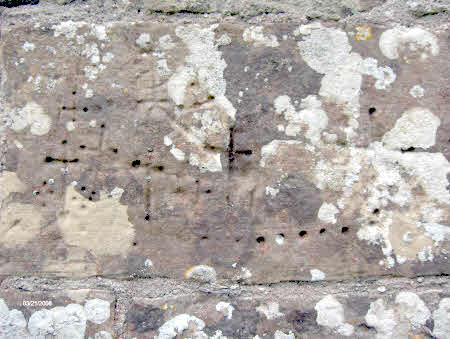
Mass Dials, sun dials and other markings on the walls of St George’s Church.
The Parish Church has eight dials of various sizes, complexity and clarity on the south wall. There is another near the west door. Some are quite small, only 3” or 4” across while others are much larger. A dial consists of a circle around a central hole for the gnomon (a rod pointing out horizontally so as to cast a shadow), which is invariably missing. The dial will also probably have some straight lines from the gnomon to the perimeter.
It is not known exactly what they were for, as the radial lines are not equally spaced and tend to be only at the bottom of the circle. Some end in ‘pock’ holes. The smaller two, at the bottom of the photo, are typical Mass dials, indicating to the priest the time for the services. The more complicated one at the top of the photo could have been to record important happenings in the Parish.
The dial above has no obvious circle but a row of pock marks under a gnomon hole. It is probably a time-telling dial, although 7 pock marks is unusual. 4 or 5 is much more common. The two ‘V’s to the right of the gnomon hole is probably a mason’s mark.
These circles are found on the west wall near the door to the bell tower. It is quite different to any of the other dials and is probably not a dial at all. The pock mark in the centre is too shallow to have held a gnomon and there do not seem to be any distinct radial lines. It is also on the west wall which would have made it useless as a sun or mass dial.
Two concentric circles usually denote consecration rings – to commemorate the blessing of a new church by the Bishop – but these are usually painted and inside the Church. Perhaps it commemorates the consecration of the West Tower which was a later addition. It is also possible that the stone was reused for the later building carrying its marking with it from its original site.
Near the dials are twelve votive crosses. These are often called Crusader crosses and are believed to have been scratched by Crusaders on their way to the Holy Land, or to give thanks for a safe return. Why Fovant should have so many is not clear. Perhaps our proximity to Ansty, where there was a Crusader Hospice built and maintained by the Knights of St John, may provide an answer. It is possible they were to commemorate much more prosaic promises by ordinary parishioners or visiting people. In the midst of these crosses is a ‘globe’ with an ‘equator’ and a half circle at top and bottom. An interesting but puzzling graffiti.
Researched and written by M.A. McKenzie with a lot of help from Tony Woods of the Mass Dial Group of the British Sun Dial Society. They are creating a register of all dials in Britain. Their website can be found here.
M.A.M.
31 December 2008




